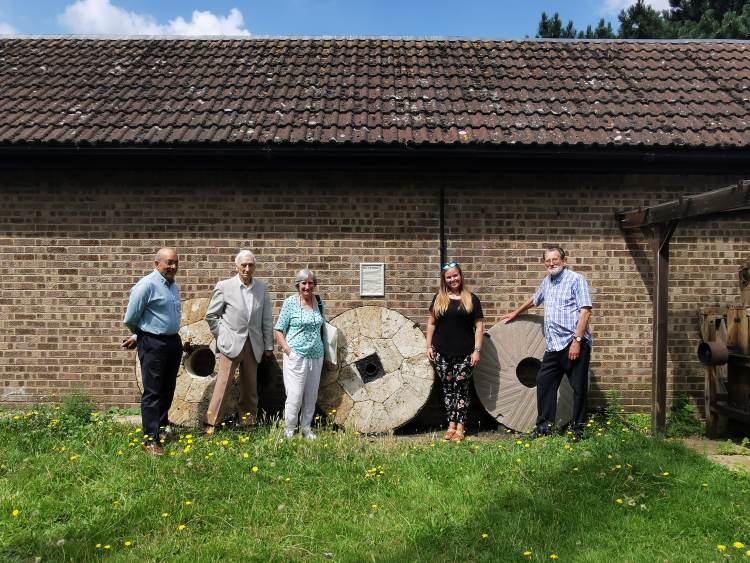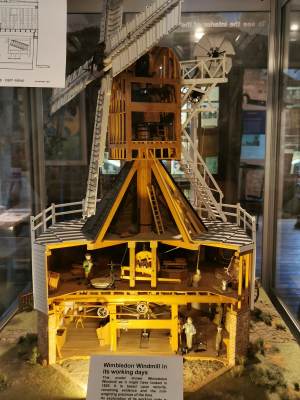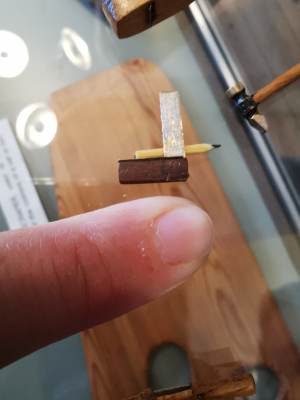Last Friday, Liz, Mildred and I had a delightful visit to Wimbledon Windmill, one of the Mills Archive’s Heritage Partners.

On our arrival we were greeted by a friendly bunch of trustees and volunteers who help to look after the mill, headed by their Chairman, Asif Malik, and their curator Norman Plastow, a mill enthusiast and former architect and conservationist who has been a leading figure in the restoration and conservation of the mill for decades.

We were very lucky to be given a guided tour by Norman himself, who is an extremely knowledgeable and modest gentleman with a playful sense of humour, who began by telling us a bit about the history of the windmill.

Situated right on Wimbledon Common, the mill was built in 1817 by a carpenter named Charles March, permitted by the Manor Court as ‘a public Corn Mill for the advantage and convenience of the neighbourhood’. It was built as a hollow post mill, with the post and the machinery enclosed by an octagonal, two-storey structure; the ground floor made of brick and the first floor of wood.
It had a relatively short running life, ceasing operation in 1864 and then being renovated into flats for six families. The wooden slatted walls of the first storey were replaced with brick, and fireplaces and chimneys were added, making it warmer and less draughty for the residents. This gives the mill its unusual look of being a windmill on top of a house!
Unlike some mills that have undergone residential renovation, Wimbledon is extremely lucky to have kept its features that keep it looking like a windmill, including the conical tower supporting the cap, and the sails, which were restored to working order with the help of a grant from the Heritage Lottery Fund. Today the sails are able to rotate, and the view of the mill is iconic to Wimbledon residents and visitors alike.

First of all the team showed us around the downstairs gallery of model windmills, each one tiny representation of a real-life British mill. Every single model was astoundingly accurate, with attention to detail that really brought the mills to life: varying from slight colour changes in the brickwork due to weathering, to a figuring of a cat inside the mill, keeping an eye out for any pesky mice! We were enthralled by these incredibly realistic models – the sails even rotated at the push of a button.
The museum on the first floor of the mill is home to several milling artefacts, such as tools and machinery from Wimbledon Mill and from others, and to a display of Scouting artefacts (as the plaque on the front of the mill declares, in 1908 Robert Baden-Powell, Chief Scout of the World, wrote parts of Scouting for Boys in the adjacent millhouse.) You can see the original millstones, with labels pointing out the different parts such as the hopper, horse, damsel, crook and willow (very handy for non-mill experts like me!). One section of the first floor has been kept as what it would have looked like when it was the residence of a local seamstress, to give you an idea of the living conditions in the old mill – cramped but cosy was my conclusion!

I was specially allowed to climb the steep ladder into the tower of the mill, which supports the cap. This was very exciting as visitors aren’t usually allowed! Dark and atmospheric, the tower is hugely different from the relatively light and airy first floor. You go from being in a once-residential space to suddenly feeling very much inside a traditional mill, where you can see all the wooden timbers which comprise the tower’s structure. I got a tingle down my spine reading the names of millwrights and long passed who had written their names and the jobs they undertook on the mill – a long list of names that went back possibly to the 1800s!
Liz’s favourite bit was having a go at grinding corn on the ancient saddle quern – a historical artefact that we were told was brought over from Mexico in hand luggage! (Must have been a rather heavy journey!) We were surprised at how difficult it was to grind the corn – the people who once used it must have been much stronger and more used to hard physical labour than we are!

Norman explained each aspect to us as we went around, all of which was fascinating. One thing I learnt which I’ve wondered at in the past was why millstones have different patterned grooves in them: they funnel the flour out sideways rather than letting it collect between the stones. Different regions and countries had their own ideas about which groove pattern was best, hence the variation of designs. I think I almost learnt as much about mills that day than I have in the past year! It was great to be able to see the artefacts in the flesh – it’s much easier to understand how they work than by reading about them in books or looking at photos.

Upstairs there is also another small-scale windmill model, this one of Wimbledon Windmill itself, made by none other than our guide, Norman. It’s strange to be inside the windmill, looking at another version of the building you’re standing in – you almost expect to look inside and see a little figurine of yourself, gazing at an even tinier windmill model! This one was cut in half so that you could see all the workings of the inside of the mill – each tiny part accurate, and all of it moving and working at the press of a button.
I was incredibly impressed by this, and even more so at Norman’s next revelation, which instantly became my favourite thing in the museum. He asked us if we’d like to see the tools he used to build the model; eagerly turning around, I was looking for a box of modelling tools in one of the display cases, so was surprised when he produced out of his pocket a tiny wooden tool box, only a couple of inches long.

Inside was a whole selection of absolutely miniature millwrighting tools, the biggest only a few centimetres long, and each one as accurate and intricate as they are in real life – perfect, delicate versions of their larger versions. Saws, hammers, chisels, files; and a tiny little set square and pencil (with real led in it) which was smaller than my fingernail! I was speechless at the detail and work that Norman must have put in to them.

The whole visit was fascinating and thoroughly enjoyable, and it’s wonderful to see the passion and commitment of the team shining through, and their love for the mill they look after. A massive thank you to Asif, Norman and the team for showing us round and making it such an interesting visit – we’ll certainly be back in the future.
Oh, and just in case you’re wondering – yes, there were a couple of sightings of Wombles; Mildred even took one away with her from the Museum shop!
Wimbledon Windmill Museum is free to visit and is open to visitors on Saturdays, Sundays and Bank holidays until October – more information about visiting, events and its history is available on their website: https://www.wimbledonwindmill.org.uk/.
You can view photos and documents on Wimbledon Windmill in the Mills Archive catalogue here: https://catalogue.millsarchive.org/post-mill-wimbledon-common.